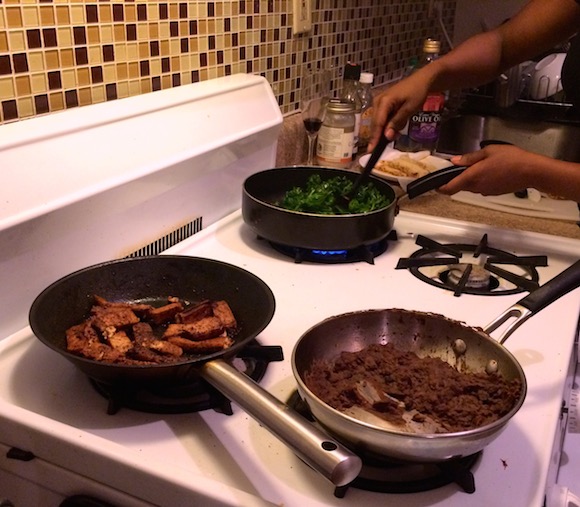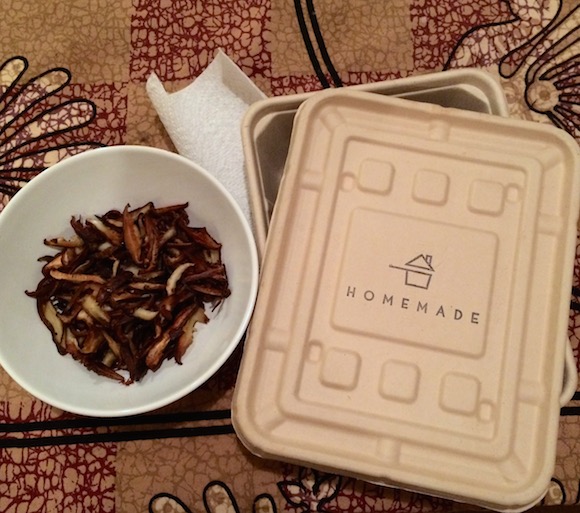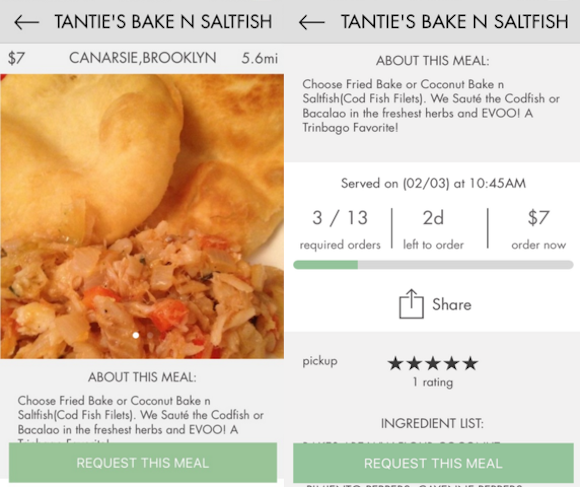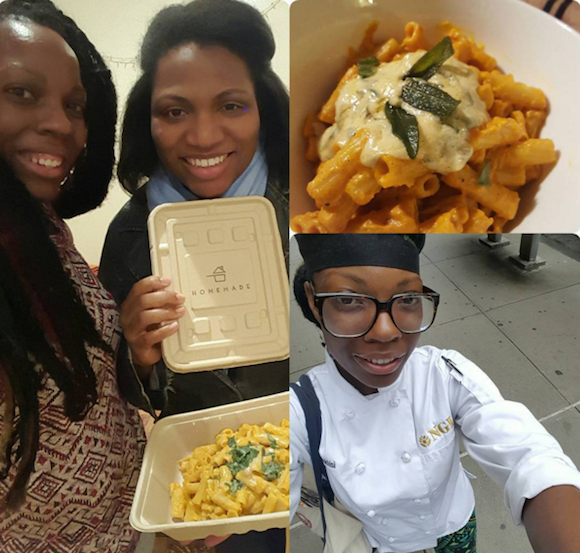
ICYMI in last month’s news, there’s a new cooking app on the rise called Homemade, and it lets you sell food out of your home as if you were your very own take-out joint. For consumers, that means getting to sample local flavors and engage with members of the community. For users, it means covering the cost of your weekly groceries, and maybe even more.
Naliaka Wakhisi is one of Homemade’s most popular chefs. A Bed-Stuy resident originally from Miami, by way of Chicago, Wakhisi has been using the app since November, and has already gained a loyal following for her made-to-order vegan comfort food, which includes pumpkin mac n’ cheese, jerked tacos, shiitake bacon and more. We caught up with her over a plate of said mouthwatering tacos, to chat about her experience using app — and to find out whether she’s actually making any money from it.
_________________

Pro: The app is easy to use.
Wakhisi told us that the Homemade experience is fairly straightforward: you just pick a night to make your food, and the app helps you sell it to everyone you know.
“I wait until I’m ready to sell,” Wakhisi said. “Then, I announce it on Facebook and post pictures on Instagram of what I’m selling, saying, ‘Get your orders in by 8pm Wednesday!’ or whatever.” Once accepted onto the app as a chef (a process that involves an interview with the app’s founders and a tasting of your food), Homemade supplies its users with a number of resources, including their very own branded take-out containers for packaging the food you sell.
The app also has a Groupon-inspired feature that shows customers how many orders of a chef’s food need to be put in before “the meal is on,” so cooks can guarantee a minimum order before they start sweating over a hot stove for hours.
_________________

Con: Time commitment > profit.
This might be the deal-breaker for anyone who was hoping to open a restaurant in their kitchen but, as you might expect, selling food isn’t automatically going to become your full-time job.
“I try to calculate the price per item, and then charge $4-5 more than that,” Wakhisi told us. “But honestly, I would have to charge way more to cover pantry items. I’m not a restaurant, so I’m not getting pantry items at wholesale. And I use all organic.” She told us that she makes enough to cover the cost of her weekly grocery runs for both her customers and herself, with about $40-$50 of extra scratch per week.
For Wakhisi’s one day of cooking and selling, hey, it’s not terrible. And if your job allows you to work from home, you might just be able to rake in a couple hundred dollars a week with Homemade.
But it’s not only the food that adds up: things like the uptick in your gas bill, the extra Metrocard swipes to commute to and from the grocery store, and the phone data you might use up while promoting your brand, could all put a dent in your profits. Ask yourself whether you can really afford to spend those additional few hours a day commuting, cooking and social media-ing the crap out of your dishes.
Even with her popularity on the app, Wakhisi still needs five jobs to support herself financially and creatively. “I’m a success coach for middle school students, a social media project facilitator for a sexual health nonprofit, a bootcamp trainer, a chef’s assistant and I’m in a dance company. Oh, and a Homemade chef, now.”
_________________

Pro: It’s an honest business.
Because Homemade is such a fledgling endeavor (and longtime passion project of its founders, Nick Devane and Mike Dee) you can be sure that you’re getting a great deal of personal attention when you sign up — not the least of which is the application process itself. “[The owners] will come and talk to you, and try your food, and interview you,” Wakhisi told us. “They genuinely want you to be successful.”
Best of all — and unlike other open market platforms, such as Indiegogo — the app doesn’t collect a percentage of your sales. “They’ve never taken any money from me,” she said. “Not even a cut.” In order to make money, the app does charge a 9% fee on each order. (A meal priced at $10, for example, would end up costing the customer $10.90.)
Con: They’re still working out some kinks.
The app officially launched late last year, and features are still constantly being added and tweaked. So if you were hoping to quit your job and start wheeling and dealing on Homemade, you might want to slow your roll: there’s more grunt work than you might expect.
For example, Wakhisi told us that you can’t actually stop the orders before the listed pickup time, which means she often gets orders within minutes of that time. “I’ll post it two days before, and maybe when the day comes, I’ll only have one order. But while I’m at the grocery store, I’ll get another order. And another, and another. I usually end up having to add to the recipe as I go.”
_________________

Pro: It’s a great way to start a community.
Homemade lets you sell straight from your door, which means that you’re giving people your home address. And barring the potential for app trolls who just want to date chefs (n.b.: this has not actually happened yet), that’s actually a great way to get to know your neighbors. Since it’s location-based, you know that whoever’s swinging by to pick up your food probably lives within walking or biking distance, and you can bond over a shared love of your neighborhood while you’re handing off the food.
Wakhisi is a self-termed community organizer in Bed-Stuy, and told us that the best aspect of this app was the connections she’s been able to create between groups of friends. “If a bunch of my friends [order], I’ll tell them ‘you guys can eat it here,’ and I’ll have all these friends sitting on my couch.”
And it’s not just an excuse to host a dinner party among friends: Wakhisi has found that word-of-mouth, or food-to-mouth, has been her most powerful ally in gaining a following of strangers. “I’ve had people buy my food, get in the car, feed a bite to a friend in the car, then have that friend come in to order.”
_________________

Best of all, even though the app itself doesn’t have a built-in tipping feature, Wakhisi told us that her customers often elect to pay cash instead of through the app, so that they can leave generous tips. “Repeat customers will just say, ‘keep the change.'”
Con: You’ll need a social media following (and a smartphone) before you can build that community.
So far, Homemade is only available on Apple products. There’s a texting-only service coming soon for “dumb-phone” users, but no explicit plans to develop the app for other smartphones.
Also, since most of Homemade’s early users are budding home chefs and not hungry customers looking to replace their Seamless accounts, most of the advertising has to happen on individual social media. “You’ve got to advocate for yourself,” Wakhisi said. “Most of my customers were friends at first, or clients at the gym.”
If you’ve only got a few hundred Facebook friends or Twitter followers, none of whom live in Brooklyn, it might be hard to get started.
_______________

Wakhisi told Brokelyn that, at the end of the day, Homemade is probably best for chefs who aren’t in it for the money. “I’m not trying to turn a profit. I only cook once a week, so it’s just a better way to get my food out to the community.”
Besides, dollars aren’t the only thing we’re chasing in this world. There’s also, you know, the joy of making people happy. “Homemade has changed my life,” Wakhisi said. “It went from friends saying ‘I want to try your food!’ to me saying, ‘Now you can try my food.'”
Follow Sam on Twitter for more tales of the hustle at @ahoysamantha
3 Comments
Leave a Reply




I know NYC is Apple-crazed, but who doesn’t also at least plan to make an Android app in 2016? Android is over 50% market share in the U.S., just seems odd. (I do also have a company-issued iPhone, so I’ll survive.)
Its simply a question of development time, its much easier to develop and finalize a product on one platform or another, and then copy it onto the opposing platform. It’s not a question of one vs the other, it’s simply our tech team knows iOS, not Android.
That said, and what was not mentioned above is that we will have a mobile web platform ready to go live in the next few days. Stay tuned!
Thanks Nick, I appreciate that and hope Homemade takes off, creating the demand to port it over to Android. My Google Nexus 6P will thank you!
Meanwhile, I’ll be checking out the iOS app and looking forward to the mobile platform -oftentimes that works just as well as the app.